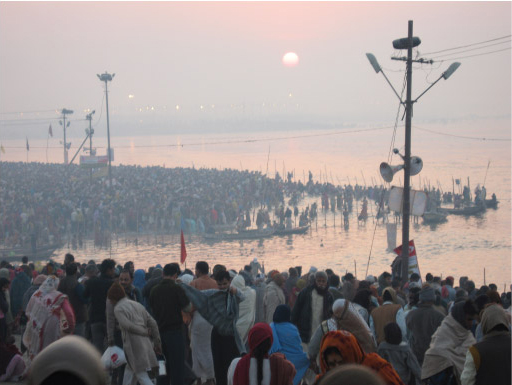1.2 Karma of the crowd: the Magh Mela pilgrimage
In the Magh Mela case study, social psychologist Nick Hopkins and his team directly tackle the debate introduced in the previous section by reconsidering the concept of ‘effervescence’. Although ‘effervescence’ suggests a bubbly personality or something that is fizzing over, if you are in a position where you are concerned with control it could suggest unboundaried and unpredictable behaviour. So, although fizzy drinks should be effervescent, large groups that are effervescent could be a problem. This was precisely the perspective of Le Bon (1895) who regarded the effervescent nature of crowds as problematic and dangerous. However, Hopkins and colleagues show how a transformative effervescence can be the key ingredient to collective self-realisation, revivifying social bonds through processes of intimacy, intensity and immediacy that transcend the everyday (Hopkins et al., 2015).
Hopkins and colleagues theorise that these social psychological processes are not especially exceptional or exotic; rather, they can be understood as continuous with our everyday ways of living in the twenty-first century. They demonstrate that events such as the Magh Mela both enhance well-being and revivify social identities. Attending the event enhances a sense of ‘shared identity’ – pilgrims, known as kalpwasis, who attend the Magh Mela for the whole month see and embrace each other as members of the same group. This recognition and sharing of identity means fellow kalpwasis relate to each other with a higher level of intimacy and helpfulness. This change in boundaries leads to a construct that Hopkins and colleagues term ‘collective self-realisation’ (CSR). This self-realisation and shared identity serve to enhance well-being.
In a longitudinal component of the case study, the Magh Mela research team looked at people’s performance of their identity both before and after attending the Magh Mela, comparing this to people who were Hindus but did not attend the event (non-attendees). What they found was that kalpwasis who had been to the Magh Mela and had mixed with other kalpwasis saw themselves as a collective group, i.e. they had a shared identity. When the kalpwasis returned home, they practised more Hindu rituals and had a stronger self-identification as a Hindu. In this sense, the fact that they were able to enact the rituals and way of living associated with their identity (CSR) enabled them to maintain Hindu rituals some time after the event was finished.

